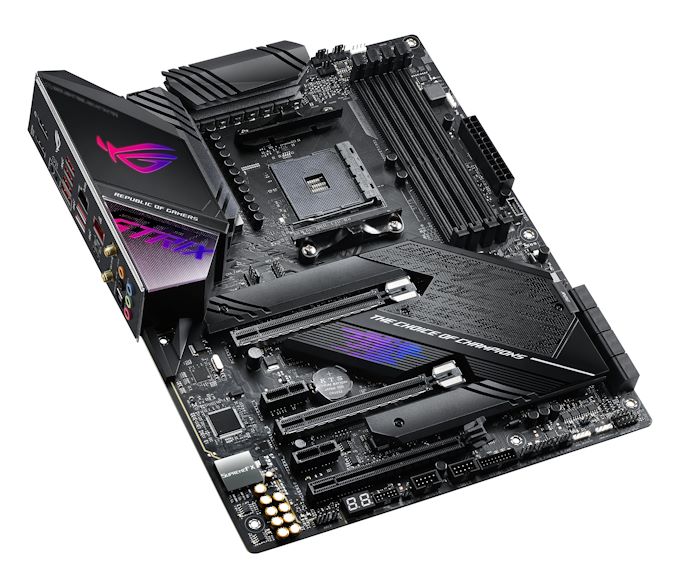The AMD X570 Motherboard Overview: Over 35+ Motherboards Analyzed
by Gavin Bonshor on July 9, 2019 8:00 AM ESTASUS ROG Strix X570-E Gaming
ASUS's Strix brand represents its more mid-range gaming focused offerings and the ASUS ROG Strix X570-E Gaming is one of two ATX sized Strix branded boards, with the X570-E being the more premium of the two models; the other being the slightly lower spec ASUS ROG Strix X570-F Gaming. Included is support for two-way NVIDIA SLI and up to three-way AMD CrossFire multi-graphics cards configurations, 2.5 Gigabit networking, and a Wi-Fi 6 wireless interface.
The ASUS ROG Strix X570-E includes the gaming-focused Realtek RTL8125G 2.5 Gigabit NIC with a second port controlled by an Intel I211-AT Gigabit NIC. The board's wireless capabilities come from the new Intel AX200 Wi-Fi 6 802.11ax adapter. The board boasts three full-length PCIe 4.0 slots which operate at x16, x8/x8, and x8/x8/x4, with the final four coming directly from the X570 chipset. The Strix themed chipset heatsink has two M.2 heatsinks emanating from the top and bottom side for the boards dual PCIe 4.0 M.2 and has a cooling fan integrated which is designed to keep the X570 chipset cool. The ROG Strix X570-E also has eight SATA ports and four DDR4 memory slots with support for up to 128 GB.
In terms of USB connectivity on the rear panel, there are three USB 3.1 G2 Type-A, one USB 3.1 G2 Type-C, and four USB 3.1 G1 Type-A ports. A SupremeFX S1220 HD audio codec powers the five color-coded 3.5 mm jacks, and an S/PDIF optical out, while a pair of video outputs consisting of an HDMI 2.0 and DisplayPort 1.2 output is featured. A handily located BIOS Flashback button and a single USB 3.1 G1 Type-A dedicated to this are clearly highlighted, and the ROG Strix X570-E also benefits from dual Ethernet ports with one being controlled by a Realtek RTL8125-CG 2.5 Gigabit NIC, while the other is driven by an Intel I1211-AT Gigabit NIC. There are also two antenna inputs for the Intel AX200 802.11ax Wi-Fi 6 wireless interface which also adds BT 5 connectivity into the mix.
The ASUS ROG Strix X570-E Gaming has an MSRP of $330 and represents its bridge between the mid-range and the higher end Crosshair VIII models. With Wi-Fi 6, 2.5 Gigabit + 1 Gigabit NICs and a SupremeFX S1220A HD audio codec and two-way NVIDIA SLI support, users looking for a high-quality ASUS X570 model may not have to look further than the Strix X570-F.












225 Comments
View All Comments
Supercell99 - Tuesday, July 9, 2019 - link
I also expected benchmarks and a naked woman serving me a beer.haukionkannel - Wednesday, July 10, 2019 - link
You did not get that? That is really strange... I was sure that that was the basic service in here!;)
Gastec - Wednesday, July 10, 2019 - link
I had a dream last night about a woman, she was serving me...benchmarks :)Duncan Macdonald - Tuesday, July 9, 2019 - link
Why is the DDR4 memory speed being shown as a feature of the chipset? The memory is directly driven by the CPU not the chipset and as such the memory speed is independent of the chipset.Dug - Tuesday, July 9, 2019 - link
The motherboard still has work to do and is what supports the faster speed memory. Just because the cpu allows it, doesn't mean it will work without the correct chipset.thomasg - Tuesday, July 9, 2019 - link
The chipset has nothing to do with it, it has no relation to RAM clock and is exclusively driven by the PCIe clock, which is unrelated.The mainboard itself has the traces and therefore the manufacturer is expected to provide appropriate timing sequences to load into the CPU, which again, is not done on the chipset.
There's no reason a mainboard manufacturer couldn't support faster RAM on any older, compatible board (provided they do a firmware update and the board is designed well enough), a chipset upgrade is not required.
Death666Angel - Wednesday, July 10, 2019 - link
"the board is designed well enough" There is the catch. It might be that Ryzen being the first of its kind meant that many 3xx boards were designed poorly.First test I've seen is TPUs R9 3900x on a ASUS Prime B350 Plus which they claim ran at 3200CL14, but only after setting it to 2666MHz first and letting it train the memory. But it's an encouraging result.
Dug - Tuesday, July 9, 2019 - link
I'm interested in seeing what coolers will fit on the mITX boards. Specifically ASRock X570 Phantom Gaming-ITX TB3.It looks like some of these boards might be limited due to high heatsinks and fans on the motherboards.
Mikewind Dale - Tuesday, July 9, 2019 - link
Could we please have a comparison table? 35 pages is too many read. It would be useful to have a comparison table so that I can narrow down the several motherboards I am interested in, and then compare their prices.halcyon - Tuesday, July 9, 2019 - link
A summary table of features would indeed be very helpful. Way too many boards and pages...